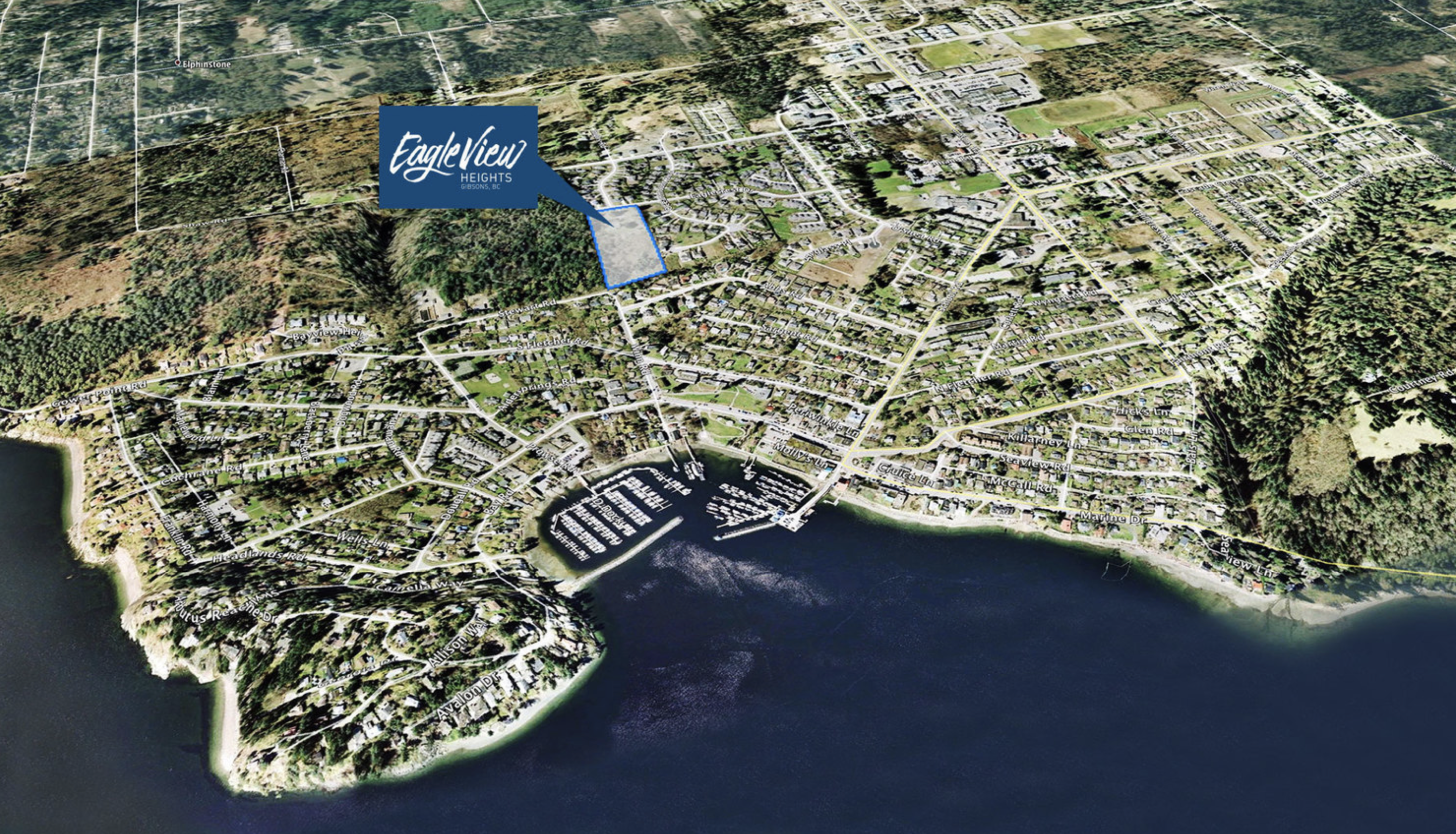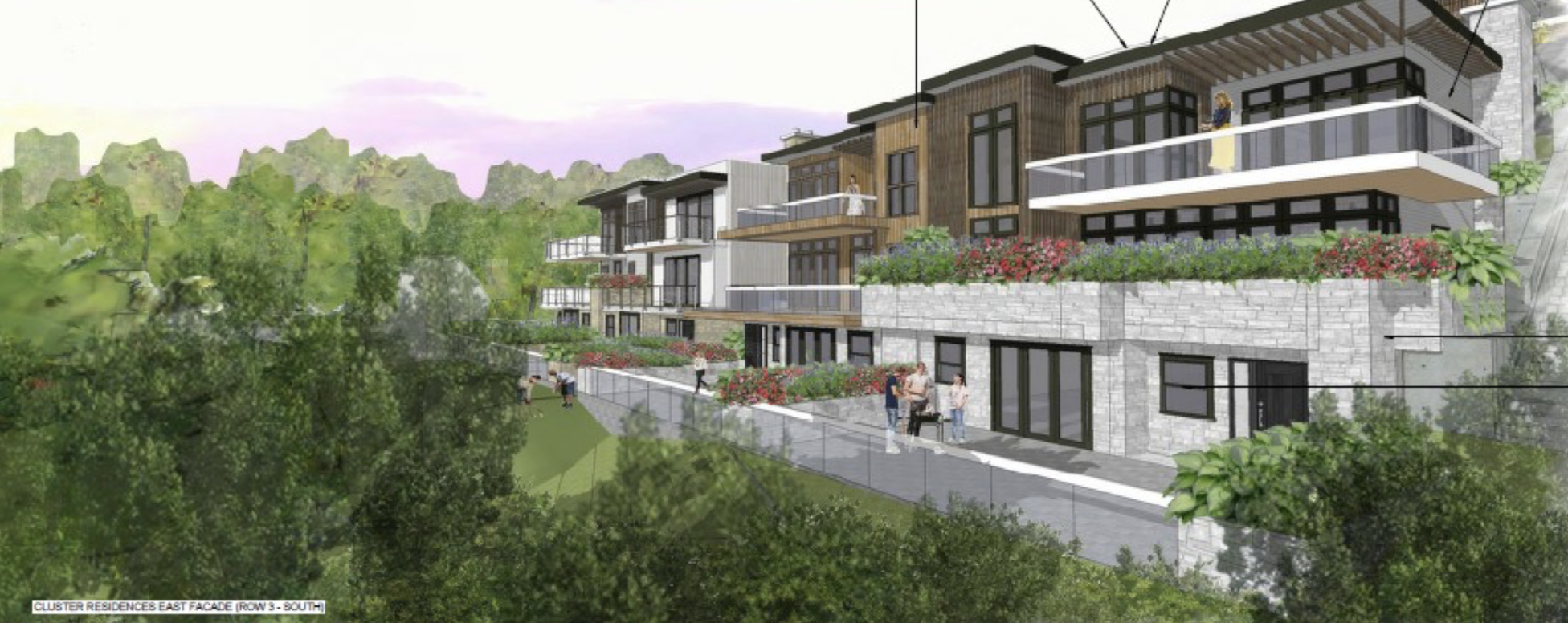
Neighbourhood association expects confrontations at council meetings and public hearing. “63 more units in a neighbourhood of 77 is overwhelming’
By Newsdesk
A meeting last Wednesday between Eagle View Heights developer Stanley Yasin, architect Tim Ankenman, and the O’Shea Oceanmount Community Association (OOCA), which opposes the 87-unit development between Stewart Road and Eaglecrest Drive, left no one satisfied.
“They are pretty committed to this project, and to hell to those who don’t agree,” OOCA director William Baker said. “Did anybody change their mind? I don’t think so.”
The OOCA had invited Yasin and Ankenman to the meeting at the Gibsons public library, which about 40 neighbourhood residents attended.
Yasin and Ankenman did their best to explain the advantages of the project: local people will have first choice and about 100 people have already expressed interest in buying one of the 87 units, they said.
The units are geared toward empty-nesters and people who want to downsize so that their larger homes — and their suites — can enter the market, increasing the supply of homes, said Ankenman.
“People will be able to stay in your community, that’s why I am standing here fighting for this project,” he said.
Asked why part of Eagle View Heights’ website is in Chinese if the development is geared toward local people, Ankenman answered that one of the partners, who is Chinese, just wants to show off to his mom and dad in China.
“A lot of the comments at the public information meeting [on January 30 at Gibsons Public Market] were racist, so that’s all I am going to say about that,” he said.
The developer will pay “hundreds of thousands of dollars” towards affordable housing, Yasin and Ankenman said. The development-cost charges and community-amenity charges are estimated in excess of $1.2 million, and more than $100,000 will be donated for the Armours Beach restoration plan.
An earlier version of the design included 14 units of affordable housing, but when the number of units dropped from 100 to 87, that option was abandoned.
Yasin and Ankenman tried to assure the audience that traffic will not increase significantly; the average time between cars passing, even at peak times and in summer, would be three minutes.
“We listened to your concerns about loss of view,” they said. “That’s why we lowered the height of the buildings and opted for flat roofs.”

To address fears of water run-off, the roofs will be covered with moss, retaining water. A large stormwater-retention pond halfway down the property will collect excessive rain water. To keep mosquitos at bay, it will be outfitted with a circulation pump and a small fountain.
“Even if the pond were to overflow, the water will be captured by two drainage swells. The properties on the lower bench [of the development] will never flood, and neither will the properties on Abbs,” said Ankenman.
To preserve seaside village character, every building will have a different design, using natural materials.

All parking stalls will be outfitted for electrical vehicles, they said.
The strata will maintain right-of-way on the pathway on the property, in addition to the pathway already there, and both will be available to everyone — except the disabled, due to the steepness of the slope. They can access the complex through the elevators at the lower bench at Stewart Road.

Fire trucks will not be able to access the lower bench but firemen can go up in the car elevators. The buildings will have sprinkler systems and fire hoses can be hooked up to standpipes outside.
Short-term rentals will not be allowed in the development.
The content of 100 comments submitted at the public information meeting on January 30 was a contentious issue.
“In general, there is overwhelming support for our project,” Ankenman said. Audience members wondered if there was a way to check that statement by looking at the comments, but Ankenman declined.
After the meeting, Baker said it bothered him that town staff had been present at the January 30 public information meeting, but had left it to the developer to collect the comments and forward them to the planning department.
“It should have been the other way around. I don’t trust a process where the developer controls the comments, saying his project has overwhelming support. The integrity of such a process is pretty suspect. I’m not saying anything untoward happened, but the optics are really poor. I hope council will look at these results critically. In my opinion, they are tainted.”
The Coast Clarion sought clarification from Lesley-Ann Staats, the town’s director of planning, but she did not return phone calls. Gibsons council has asked staff to report on the results of the January 30 meeting, and the comments are part of that process.
Baker called the Eagle View Heights development overwhelming. “In a neighbourhood of 77 homes, 63 extra housing units are proposed. And that’s called low-density? I expect confrontations at council meetings and the public hearing. This is a pretty divisive issue.”
To clarify – there are 77 single family homes in the Upper Bench where 63 units are proposed, an 82% increase in housing units in the nearby neighbourhood. There are an additional 24 units proposed for the Lower Bench.
Divisiveness doesn’t exist in the affected neighbourhood. The vast majority are opposed to the development as being too many units on too small a land base and not representing a “seaside village character” as envisioned in our Official Community Plan.